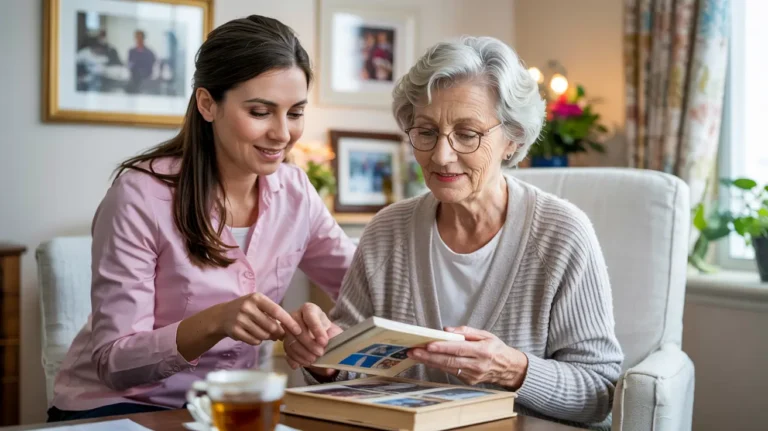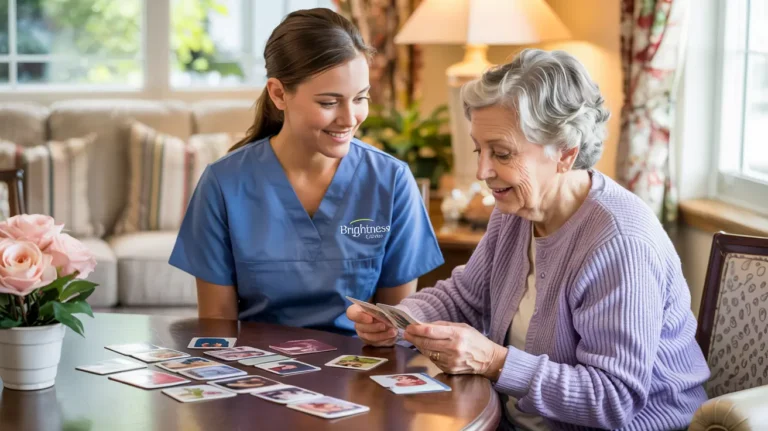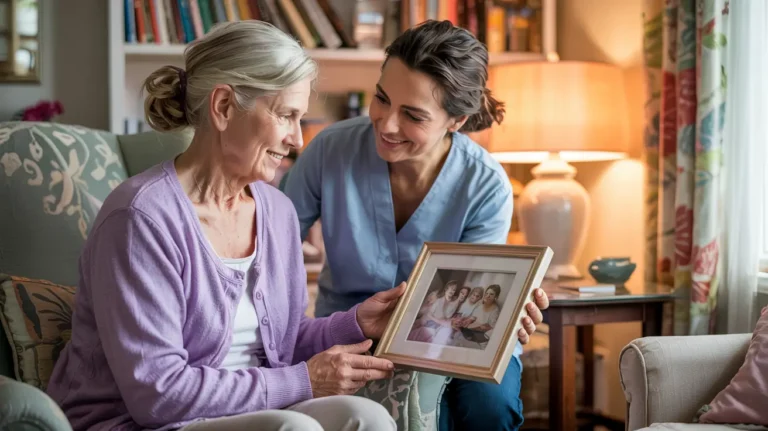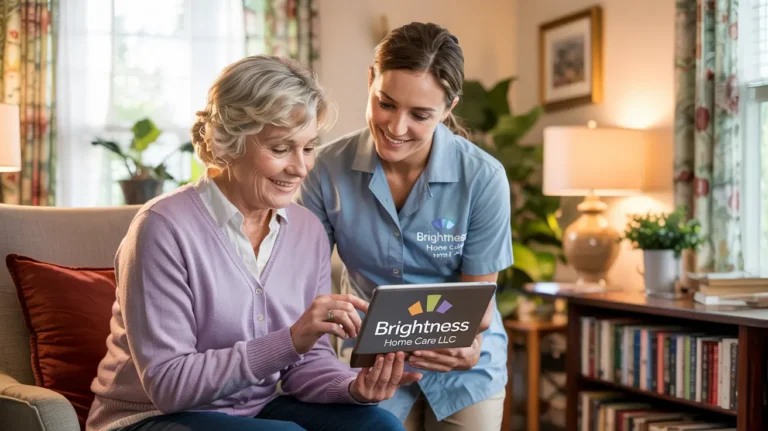Engaging Memory Care Activities in Indianapolis: A Complete Guide for Caregivers
Did you know that nearly 6 million Americans are currently living with Alzheimer’s disease? That number hit home for me when my own uncle was diagnosed with dementia three years ago. Suddenly, statistics became personal, and I found myself navigating the challenging world of memory care activities.
Memory care isn’t just about keeping someone safe and healthy—though that’s certainly important. It’s about creating meaningful moments, preserving dignity, and finding new ways to connect when traditional communication becomes difficult. Activities aren’t just time-fillers; they’re vital tools for cognitive stimulation, emotional well-being, and quality of life.
Here in Indianapolis, we’re fortunate to have a range of resources for memory care, with Brightness Home Care LLC standing out as a leader in personalized approaches to memory support. Located in the heart of the city at 4911 West 38th Street, they’ve developed innovative activity programs that can be tailored to each individual’s needs, interests, and abilities.
Whether you’re a family caregiver looking for fresh ideas or a professional seeking to enhance your memory care approach, this guide will walk you through effective activities across various domains—sensory, creative, musical, physical, social, and cognitive. I’ll share what I’ve learned through both professional experience and personal trial-and-error, including which Indianapolis resources have proven most valuable along the way.
Understanding Memory Care Needs in Indianapolis
Memory care isn’t one-size-fits-all, especially when it comes to activities. The approach that works brilliantly for someone with early-stage memory loss might be completely overwhelming for someone with more advanced cognitive changes. I learned this lesson the hard way when I first started working with memory care patients—I’d plan elaborate activities only to watch them fall flat because they weren’t matched to current abilities.
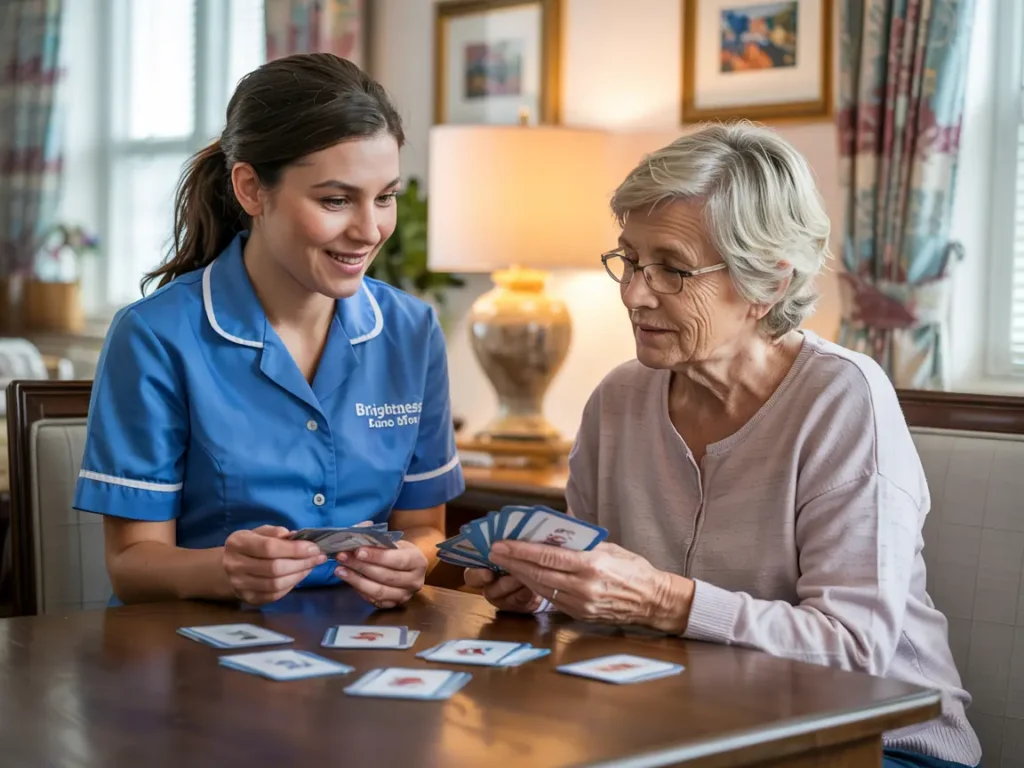
For early-stage memory loss, activities can be fairly complex with minimal adaptation. Focus on preserving existing skills through mentally stimulating games, social engagement, and physical activity. Indianapolis offers excellent early-stage programs through the Alzheimer’s Association’s Early Stage Social Engagement Program, providing opportunities for both stimulation and peer connection.
Middle-stage memory loss requires more structured activities with clearer instructions and fewer steps. This is where many Indianapolis families start to struggle, especially during our harsh winter months when getting outside becomes challenging. Brightness Home Care specializes in adapting activities for this middle stage, where support is needed but independence can still be fostered in many areas.
For advanced memory loss, sensory experiences often become more important than outcome-oriented activities. The texture of fabric, the smell of familiar spices, or the sound of beloved music can create moments of connection when words fail. Indianapolis’s changing seasons provide wonderful sensory opportunities—from the smell of spring flowers to the sound of fall leaves crunching underfoot.
Personalized activities aren’t just nice to have—they’re absolutely essential. I worked with a retired mechanic who would become agitated during most group activities but would spend hours contentedly sorting nuts and bolts by size. The activity connected to his identity and gave him purpose. Brightness Home Care excels at this personalized approach, taking time to learn each client’s history, preferences, and abilities before designing their activity plan.
Indianapolis has some unique considerations for memory care activities. Our distinct seasons mean outdoor activities require careful planning—hot, humid summers and cold, icy winters create safety challenges. Our spread-out city layout can make transportation to community activities difficult for those who can no longer drive. These factors make in-home memory care services particularly valuable in our community.
Family involvement makes an enormous difference in successful memory care. Even the best-designed activities are more engaging when they incorporate familiar faces and voices. I’ve seen remarkable moments of connection when families participate in activities alongside their loved ones. Brightness Home Care encourages this family engagement, providing guidance on how to adapt interactions as cognitive changes progress.
Understanding behavior as communication is fundamental to effective memory care. When someone becomes agitated during an activity, they’re not being “difficult”—they’re communicating that something isn’t working for them. Maybe the activity is too complex, the environment too noisy, or they’re experiencing physical discomfort. Listening to these behavioral cues helps us adjust our approach.
Indianapolis caregivers often report feeling isolated in their memory care journey. Connecting with support groups and resources isn’t just helpful for activity ideas—it’s essential for caregiver wellbeing. The Greater Indiana Chapter of the Alzheimer’s Association hosts regular support groups throughout the city, providing both emotional support and practical activity suggestions.
Above all, understanding memory care needs means recognizing the person behind the diagnosis. Their lifelong preferences, professional history, cultural background, and personal interests should shape their activity plan. Memory loss changes abilities but doesn’t erase identity. The most successful memory care activities honor who the person has always been while adapting to who they are now.
Sensory Stimulation Activities for Memory Care Patients
Sensory activities often succeed when other approaches fail. I discovered this almost by accident when a normally withdrawn client became animated and engaged while handling fabric samples with different textures. That moment taught me that when cognitive processing is challenging, direct sensory experiences can create powerful connections.

The science behind sensory activities is fascinating. Different sensory inputs are processed in different parts of the brain, so when memory and language areas are affected by dementia, other sensory processing areas may remain relatively intact. This explains why someone might not recognize a photo of a rose but will smile at the scent of rose essential oil—the olfactory processing bypasses damaged cognitive pathways.
Here in Indianapolis, our changing seasons offer perfect opportunities for seasonal sensory activities. Spring brings fresh flowers for gentle fragrance stimulation. Summer offers the sounds of birds and insects in our parks. Fall provides colorful leaves with interesting textures. Even winter can be sensory-rich with the feel of soft scarves, the smell of cinnamon, and the sight of falling snow through a window.
Creating a simple sensory box is one of the easiest and most effective activities for home care. I recommend collecting items with different textures (smooth stones, rough pine cones, soft fabric), scents (coffee beans, cinnamon sticks, lavender), and visual appeal (colorful scarves, shiny objects, family photos). Brightness Home Care helps families develop personalized sensory kits based on their loved one’s preferences and history.
Food-based sensory activities work remarkably well but require careful attention to dietary restrictions and swallowing abilities. Something as simple as slicing an orange can provide stimulation through the sight of bright color, the smell of citrus, the feel of the fruit’s texture, and potentially the taste if sampling is appropriate. These multi-sensory experiences often trigger memories and conversation.
Music provides powerful auditory stimulation that can reach people even in advanced stages of dementia. Indianapolis has wonderful music therapy resources, but even playing favorite songs at home can create meaningful engagement. Brightness Home Care often incorporates personalized playlists into their clients’ daily routines, matched to different times of day and specific care activities.
The sense of touch remains important even in late-stage dementia. Hand massage with scented lotion, brushing hair, or simply holding hands provides comfort and connection through touch. These simple sensory experiences don’t require complex cognitive processing yet provide meaningful human connection.
For visual stimulation, Indianapolis offers beautiful opportunities through our parks and cultural institutions. The butterfly garden at White River State Park provides gentle movement and color during warmer months. For indoor options, the Indianapolis Museum of Art offers sensory-friendly visiting times with reduced crowds and adjusted lighting.
I’ve found that nature-based sensory activities have particularly strong positive effects. The combination of fresh air, natural light, bird songs, plant scents, and varied textures seems to engage multiple senses simultaneously in a way that’s both stimulating and calming. Even bringing natural elements indoors—pinecones, flowers, leaves—can create meaningful sensory experiences.
Safety is paramount with sensory activities. Materials should be non-toxic, appropriately sized to prevent choking, and suitable for the person’s specific cognitive stage. Brightness Home Care staff receive specialized training in safe sensory engagement techniques, ensuring that activities provide benefits without risks.
Time of day significantly impacts sensory processing. Many people with dementia experience increased sensitivity and decreased processing ability in late afternoon and evening (often called “sundowning”). Mornings and early afternoons are typically better times for more stimulating sensory activities, while evenings call for calming sensory experiences like gentle music or soft lighting.
Brightness Home Care in Indianapolis has developed what they call “sensory moments”—brief, purposeful sensory experiences incorporated throughout daily routines. A lavender-scented warm towel before bedtime, bird songs playing during breakfast, or textured fabrics to handle during seated rest periods turn ordinary moments into cognitive stimulation opportunities.
The most important principle I’ve learned about sensory activities is to watch closely for responses and adapt accordingly. Someone might find certain scents comforting that others find agitating. Sounds that are pleasantly stimulating for one person might be overwhelming for another. The key is personalization and careful observation of responses.
Creative Expression and Art Therapy Options
Art activities open doors of expression when words become elusive. I’ve witnessed remarkable moments where someone who struggled to communicate verbally could express complex emotions through color and form. Creative activities aren’t just about producing art—they’re about providing alternative channels for communication and self-expression.
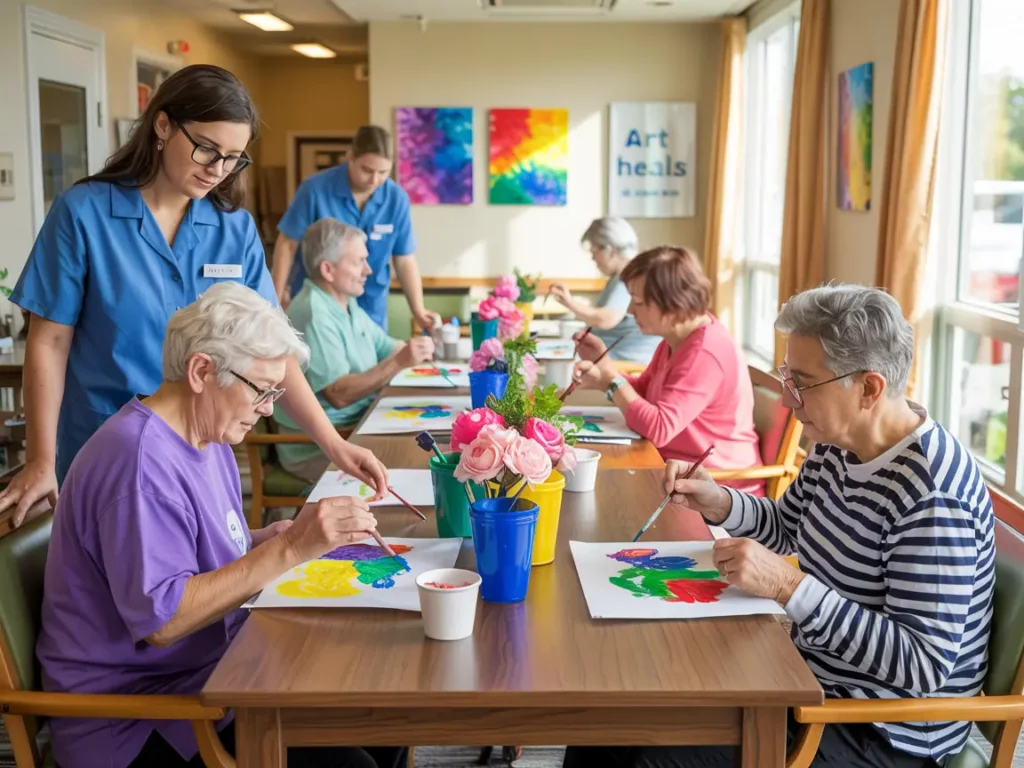
Indianapolis offers several specialized art therapy resources for memory care. The Indianapolis Art Center occasionally offers classes specifically designed for those with cognitive challenges. Art therapists at Joy’s House adult day services create wonderful adaptations of art projects for various ability levels. For in-home options, Brightness Home Care can arrange for art therapists to visit clients or train caregivers in basic art facilitation techniques.
The beauty of creative expression for memory care is that there are no wrong answers. Unlike many other activities where “mistakes” can be frustrating, art allows complete freedom of expression. This can be incredibly liberating for someone who experiences frequent correction or redirection in other aspects of daily life.
Simple art materials often work best for memory care. I’ve found that offering too many choices or complex materials can be overwhelming. Watercolor pencils that activate with a wet brush, chunky crayons that are easy to grip, and pre-cut collage materials eliminate frustration and set the stage for successful engagement.
Brightness Home Care takes a thoughtful approach to art activities, maintaining personalized art boxes for clients with materials selected to match their abilities and preferences. Their caregivers receive training in art facilitation techniques—knowing when to offer assistance and when to step back, how to provide just enough structure without limiting expression.
Photography offers another creative avenue, even for those with limited dexterity. Simple digital cameras with large buttons allow for artistic expression through image capture. I’ve arranged “photography walks” around clients’ homes or neighborhoods, focusing on subjects that interest them—flowers, architectural details, or pets. Reviewing and discussing the images afterward extends the engagement.
Music and art together create powerful experiences. Playing favorite music during art activities often enhances engagement and emotional expression. I’ve observed people who seemed disconnected suddenly become focused and expressive when their preferred music accompanied an art activity.
Process matters far more than product in memory care art activities. I made the mistake once of “fixing” someone’s artwork to make it look more “finished”—completely missing the point that the creative process itself was the valuable part, not having a perfect end result. Brightness Home Care trains their staff to honor the process of creation rather than focusing on the finished product.
Group art projects can create wonderful social connections while accommodating different ability levels. Something as simple as a group collage where each person contributes elements according to their abilities allows everyone to participate successfully. These collaborative projects often generate conversation and shared purpose.
For those in later stages of memory loss, sensory-focused art experiences work well—feeling paint between fingers, molding soft clay, or arranging textile pieces by color or texture. These activities don’t require complex instructions or cognitive processing but still provide creative engagement and sensory stimulation.
Indianapolis’s cultural heritage offers rich inspiration for memory care art projects. References to the Indianapolis 500, local landmarks, or seasonal traditions can spark recognition and conversation even when other memories have faded. Brightness Home Care incorporates these local connections into their creative programming, honoring their clients’ ties to our community.
Displaying completed artwork creates ongoing value from creative activities. Simple frames or display areas in the home validate the creative effort and provide visual cues for conversation. Family members often treasure these tangible expressions from their loved ones, especially as verbal communication becomes more limited.
The most important approach to creative activities is remaining flexible and responsive. Some days, a planned art project might not engage someone as expected. Being willing to adapt—simplifying the process, changing materials, or trying a completely different creative approach—ensures that the experience remains positive and meaningful.
Music and Memory: Therapeutic Activities
Music reaches parts of the brain that remain responsive even in advanced dementia. I’ll never forget the first time I saw someone who rarely spoke anymore sing every word to a favorite hymn perfectly. That powerful moment demonstrated music’s unique ability to access preserved memories and abilities that other approaches can’t reach.
The science behind music and memory is compelling. Musical memories are stored differently than other types of memories, often remaining accessible when other recall is severely impaired. Indianapolis has been fortunate to participate in the national Music & Memory program, which trains caregivers in creating personalized music interventions for those with cognitive impairments.
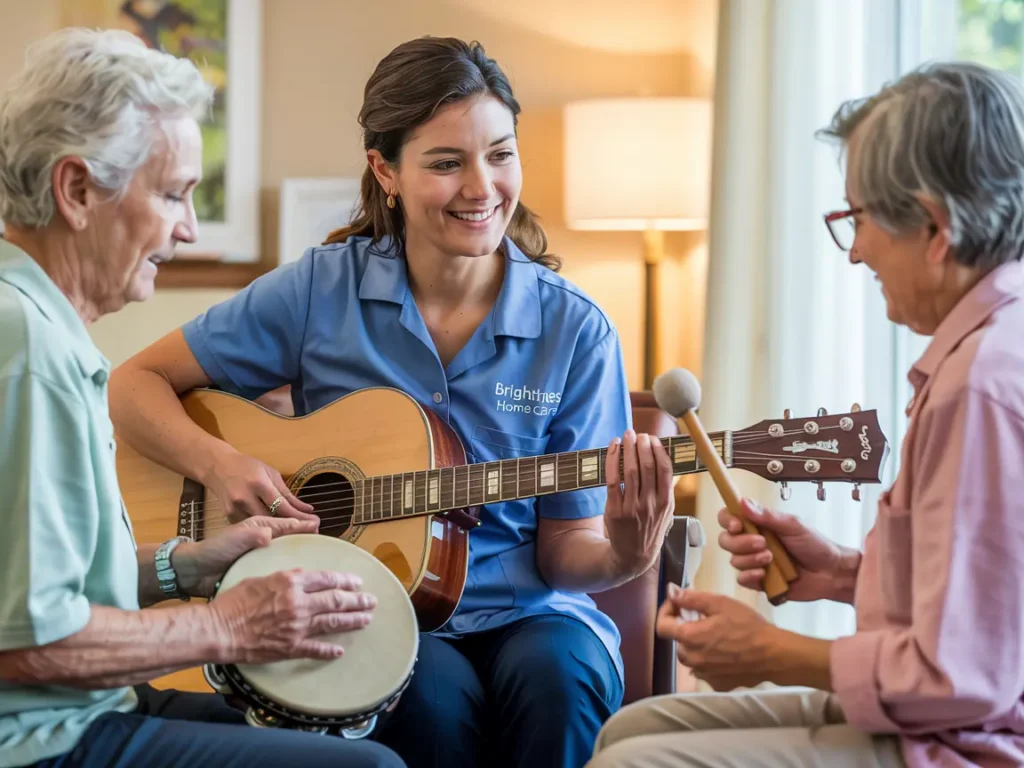
Creating personalized playlists requires detective work but yields tremendous rewards. I recommend interviewing family members about songs from different life periods—teenage years, young adulthood, middle age—to identify music with strong emotional connections. Brightness Home Care makes this music investigation part of their initial assessment process, creating detailed music preference profiles for each client.
Indianapolis has excellent music therapy resources through local universities and healthcare systems. Professional music therapists can develop targeted interventions for specific symptoms or challenges—using rhythm for gait training, familiar songs for speech recovery, or calming melodies for anxiety reduction. While not everyone needs formal music therapy, knowing these resources exist is valuable for challenging situations.
Technology has made music interventions much more accessible. Simple MP3 players with pre-loaded playlists, headphones designed for comfort and appropriate volume, and wireless speakers that caregivers can easily control have eliminated many barriers to implementing music programs. Brightness Home Care helps families set up user-friendly music systems that work for both clients and caregivers.
Rhythm instruments offer wonderful opportunities for active participation rather than passive listening. Even people with limited dexterity can often manage simple shakers, drums, or rhythm sticks. Group drumming creates social connection through shared rhythm even when verbal communication is difficult.
I’ve found that music combined with movement creates particularly effective engagement. Simple seated movements—swaying, clapping, scarf waving—add a physical dimension to musical experiences. For those with greater mobility, dance movements from their youth often remain accessible in procedural memory long after other skills have faded.
Singing together provides cognitive exercise, respiratory benefits, and emotional connection. Don’t worry about perfect pitch—enthusiasm matters more than musicality! Brightness Home Care encourages their caregivers to join in singing favorite songs with clients, recognizing that shared musical experience enhances connection.
Music can serve as powerful environmental support throughout the day. Morning music might be energetic to encourage wakefulness and activity. Mealtime music can be calming but upbeat to encourage appetite. Evening music should be soothing to signal wind-down time. This consistent musical cueing helps establish daily rhythms when cognitive tracking becomes difficult.
Indianapolis’s rich musical heritage provides wonderful local connections for memory care music programs. References to the Indianapolis Symphony Orchestra, local jazz traditions, or musical aspects of Indiana culture can spark recognition and conversation. Brightness Home Care incorporates these local musical connections into their personalized approaches.
Faith-based music often remains deeply meaningful even in advanced dementia. Familiar hymns, chants, or spiritual songs can provide comfort and connection to lifelong beliefs and communities. These musical traditions tap into deeply rooted memories and emotional associations.
Live music offers special benefits when available. Many Indianapolis senior communities host musicians, and some church groups provide music outreach to homebound individuals. The immediate interaction with live performers adds a social dimension that recorded music can’t replicate. Brightness Home Care helps arrange these live music experiences for clients who respond particularly well to musical engagement.
The most important principle I’ve learned about music and memory is to watch closely for emotional responses. Music bypasses cognitive processing and connects directly to emotional memory, which can be both powerfully positive and occasionally challenging. Being prepared to provide emotional support during music activities ensures these experiences remain beneficial.
Physical Activities Adapted for Memory Care
Physical movement benefits both body and brain, yet it’s often overlooked in memory care. I’ve seen remarkable cognitive improvements when appropriate physical activity becomes part of daily routines. One gentleman who seemed withdrawn and foggy would become alert and engaged during simple chair exercises—the physical movement seemed to “wake up” his brain in ways nothing else could.
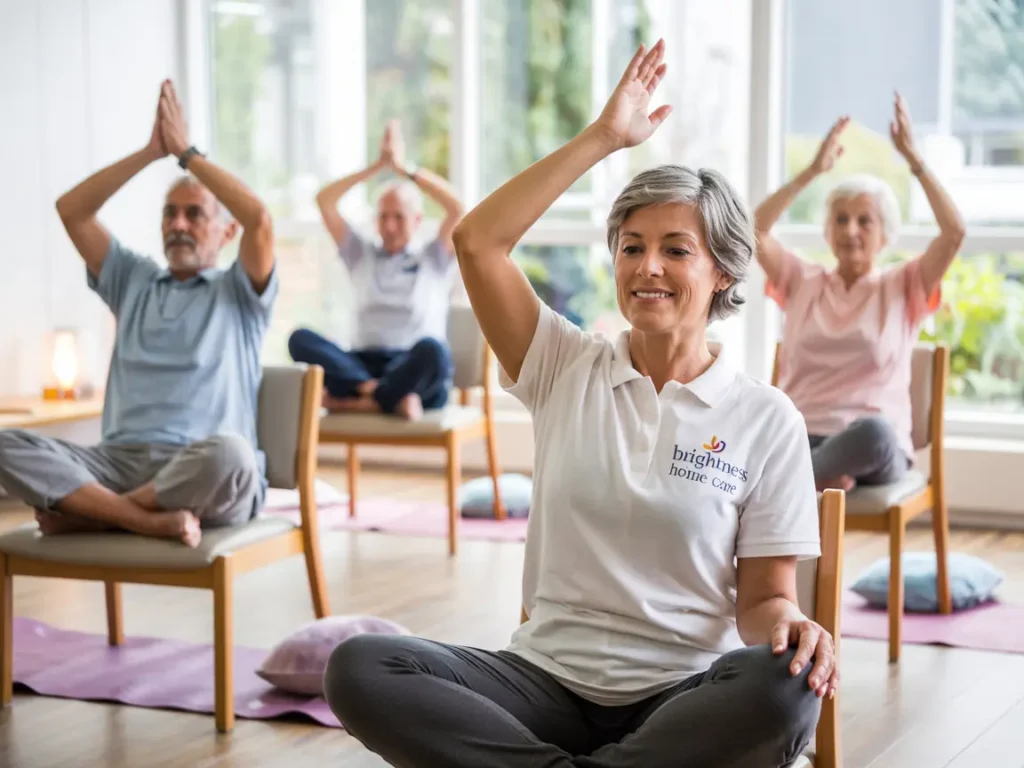
Indianapolis offers several specialized physical programs for those with memory challenges. The YMCA’s Enhance®Fitness classes include adaptations for various ability levels. Several senior centers offer seated exercise classes that welcome those with cognitive impairments. For those unable to attend community programs, Brightness Home Care incorporates appropriate physical activities into home care routines.
Safety must be the foundation of any physical activity plan. Proper assessment of physical abilities, environmental modifications to prevent falls, and continuous supervision ensure that movement activities provide benefits without risks. Brightness Home Care staff receive specific training in safe movement techniques for those with cognitive challenges.
Chair exercises form the cornerstone of most memory care physical programs. Simple seated movements can work all major muscle groups while eliminating fall risks. I’ve developed chair exercise routines set to familiar music from the 40s and 50s, finding that the musical accompaniment helps participants follow along even when verbal cues become difficult to process.
Brightness Home Care excels at incorporating functional movements into daily routines. Folding laundry becomes a standing balance exercise. Watering plants provides gentle stretching opportunities. These purposeful movements maintain practical skills while providing exercise benefits—a dual-purpose approach that respects the person’s dignity and preferences.
Indianapolis parks offer wonderful opportunities for memory care outings when weather permits. The accessible paths at Holliday Park, Garfield Park, and the Canal Walk accommodate walkers and wheelchairs while providing varied sensory experiences. Having knowledgeable companions from Brightness Home Care makes these outings safe and enjoyable.
Weather considerations significantly impact physical activity planning in our city. Indianapolis experiences everything from summer heat waves to winter ice storms, requiring flexible approaches to movement programming. Indoor alternatives—hallway walking programs, balloon volleyball, seated dancing—become essential during weather extremes.
I’ve found that pairing cognitive elements with physical movements creates powerful benefits. Simple actions like reaching high while naming something in the sky, or reaching low while naming something found on the ground, combine physical movement with cognitive challenge. The key is matching difficulty appropriately—too simple feels childish, too complex creates frustration.
Resistance activities help maintain strength when adapted appropriately. Gentle resistance bands, light hand weights, or even soup cans can provide appropriate resistance for those with adequate grip strength. The physical therapists who consult with Brightness Home Care recommend specific resistance exercises based on individual assessments.
Maintaining range of motion becomes increasingly important as dementia progresses. Simple stretching routines for all major joints help prevent the contractures and pain that can accompany decreased movement. These gentle stretches can be incorporated into daily care routines—while dressing, after bathing, or during television commercial breaks.
Brightness Home Care recognizes that physical abilities can fluctuate day to day, sometimes even hour to hour. Their flexible approach allows for adjusting activities to match energy and ability levels in the moment rather than adhering rigidly to a predetermined plan. This responsiveness ensures that physical activities remain positive experiences rather than sources of frustration.
The seasons in Indianapolis provide wonderful themes for movement activities. Spring movements might mimic gardening motions. Summer calls for swimming-inspired movements. Fall lends itself to harvest-themed gestures, and winter to snow-related actions. These seasonal connections help orient participants to time and place while providing varied movement patterns.
The most important principle I’ve learned about physical activities for memory care is that consistency trumps intensity. Brief, gentle movement sessions incorporated regularly throughout the day provide greater benefit than occasional longer sessions. Brightness Home Care trains their staff to look for natural opportunities to incorporate movement into daily routines rather than treating exercise as a separate activity.
Social Engagement Activities That Strengthen Connections
Social connection remains fundamental to wellbeing, even as cognitive changes progress. I’ve observed that meaningful social interaction—even brief moments of authentic connection—can improve mood, reduce agitation, and enhance quality of life for those with memory challenges. These connections remind us that dementia affects cognition but not the human need for belonging.

Social activities for memory care require thoughtful adaptation as abilities change. Early in the journey, traditional social gatherings might need only minor modifications. As the condition progresses, smaller groups, shorter durations, and more structure create settings where successful interaction remains possible. Brightness Home Care excels at matching social opportunities to current abilities.
Group size matters tremendously. I’ve found that groups of 3-5 people tend to work best for many in middle-stage memory care—enough interaction to be stimulating but not so many voices and faces as to become overwhelming. For those in later stages, one-on-one interaction often provides the most meaningful connection.
Indianapolis offers several memory-friendly community events. The “Memory Café” program at select Indianapolis Public Library branches provides structured socialization for those with memory challenges and their care partners. Some local museums offer sensory-friendly visiting hours with reduced crowds and adjusted environments. Brightness Home Care helps clients access these community opportunities with appropriate support.
Virtual connection options have expanded dramatically in recent years. Simple video call platforms allow homebound individuals to maintain family connections. I’ve helped set up regular “virtual tea parties” where distant family members join at a set time each week, creating reliable social routine for both the person with memory issues and their loved ones.
Role-based activities often tap into preserved social skills. Something as simple as a tea party where the person acts as host, or a situation where they can offer advice on a topic of expertise, activates deeply ingrained social patterns. I’ve watched people who struggle with everyday tasks transform when given a clear social role that connects to their identity.
Pet therapy provides a form of social connection that doesn’t rely on verbal skills or memory. The unconditional acceptance and simple interactions with therapy animals often elicit responses when human communication becomes challenging. Brightness Home Care coordinates with local therapy animal programs to bring these benefits directly to clients in their homes.
Intergenerational activities create some of the most joyful social moments I’ve witnessed in memory care. There’s something magical about bringing together those with memory challenges and young children. The reduced expectations for “normal” conversation and the focus on simple shared activities create perfect conditions for authentic connection.
Indianapolis’s rich sports culture provides wonderful conversation starters even for those with significant memory challenges. Wearing Colts blue on game days or having simple sports-themed activities creates immediate common ground. I’ve seen people who struggle to find words suddenly become animated discussing the glory days of Indianapolis sports teams.
Reminiscence groups with specific themes provide structure that makes social interaction easier. Topics like “First Jobs,” “Wedding Days,” or “Favorite Vacations” give clear focus for sharing. Visual prompts like photos or objects further support participation even when verbal abilities are limited.
Purpose projects—simple tasks that contribute to others—provide both social connection and meaningful engagement. Folding napkins for a local meal program, sorting greeting cards for troops overseas, or assembling simple craft kits for children’s hospitals gives a sense of purpose and connection to the broader community. Brightness Home Care has developed relationships with local organizations that can use these contributions.
Environmental factors significantly impact social success. Too much background noise, poor lighting, uncomfortable seating, or extreme temperatures can derail even the best-planned social activities. Brightness Home Care conducts home environment assessments to optimize conditions for successful engagement.
The most important lesson I’ve learned about social activities for memory care is to match them to previous social patterns. Someone who was always a small-group person might find large gatherings overwhelming, while a formerly gregarious person might thrive with more stimulation. Honoring who the person has always been socially shows tremendous respect for their continuing personhood.
Cognitive Games and Memory Exercises
Cognitive activities need careful matching to current abilities—this has been my most important learning in memory care. Activities that are too challenging create frustration; those that are too simple can feel infantilizing. The sweet spot is where success is likely but some effort is required. Finding this balance takes observation and adjustment.
Indianapolis has excellent resources for specialized memory care games. The public library branches offer memory kits for checkout, and the Alzheimer’s Association maintains a lending library of cognitive activities. For in-home options, Brightness Home Care maintains a collection of adaptive games and cognitive exercises matched to different ability levels.
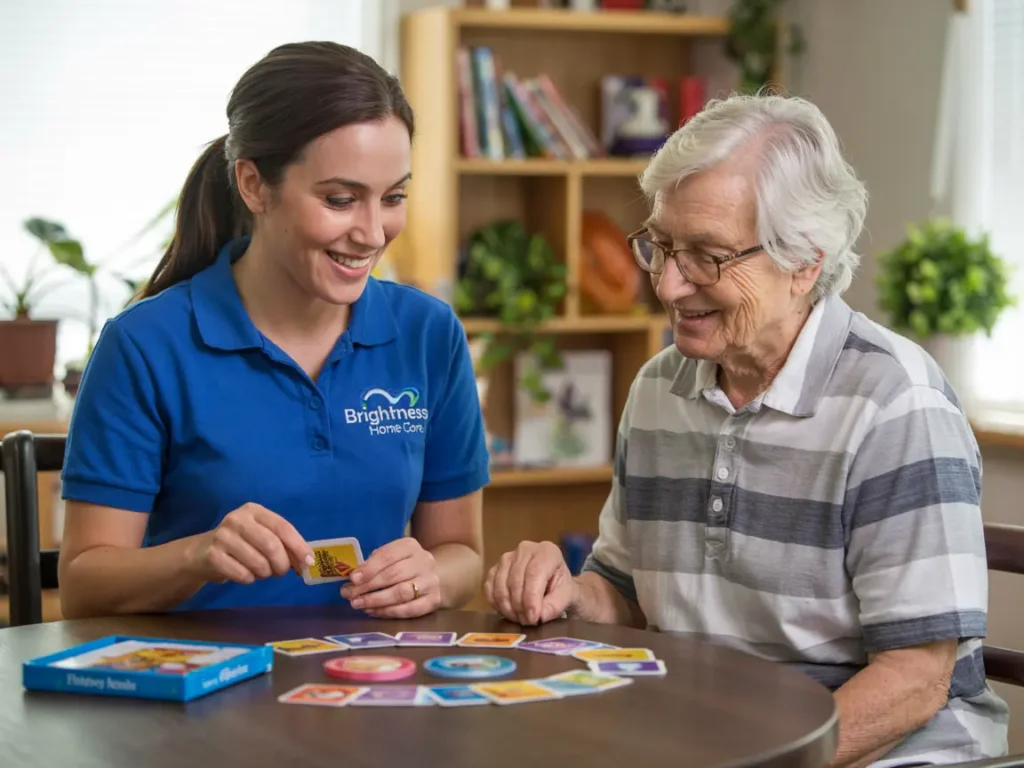
Digital vs. traditional is a question I’m often asked about cognitive activities. While there are some wonderful memory apps designed for seniors, I’ve found that physical games with tangible pieces often work better, especially for those in mid to late stages. The sensory element of handling game pieces adds an important dimension to the cognitive experience.
Simple adaptations can make familiar games accessible again as abilities change. Standard playing cards might be replaced with larger-print versions. Chess might evolve to checkers and eventually to simple matching games. These adaptations preserve the pleasure of game-playing while ensuring continued success.
Brightness Home Care has developed what they call “cognitive care packages” for their clients—personalized boxes of activities matched to each person’s interests and abilities. I love how they adjust these regularly based on changing needs and seasonal themes, preventing the boredom that can come from repetition while maintaining the comfort of familiarity.
Word games need careful adaptation for memory care. Open-ended questions like “Name all the animals you can think of” can be overwhelming. Instead, providing structure—”I’ll name a farm animal, then you name one”—supports success. Brightness Home Care trains their staff in these supportive communication techniques for cognitive stimulation.
Sequencing activities provide valuable cognitive exercise when matched to ability level. Simple 3-4 step sequences for making a sandwich or folding a napkin might be appropriate for middle-stage memory care, while later stages might work with 2-step sequences. These activities exercise executive function skills that help maintain daily living abilities.
Error-free learning approaches have transformed how I present cognitive activities. By designing tasks where success is almost guaranteed, confidence builds and engagement increases. This doesn’t mean making things childishly simple—it means thoughtfully matching challenges to current abilities and providing just enough support to ensure positive experiences.
Sorting activities often work well across different cognitive levels. Early stages might enjoy categorizing objects by multiple characteristics, while later stages might focus on simple color sorting. These activities tap into procedural memory, which often remains accessible when other cognitive functions decline.
I’ve found that timing matters enormously for cognitive games. That “sweet spot” in the day when someone is alert but not fatigued is precious time for meaningful engagement. For many, this is mid-morning, but it varies by individual. Brightness Home Care works to identify these optimal windows for each client and schedules more demanding activities accordingly.
Indianapolis’s changing seasons provide natural themes for cognitive activities. In autumn, sorting leaf shapes or identifying types of squash engages seasonal awareness along with cognitive skills. Winter snow patterns, spring flowers, and summer produce all offer similar opportunities. These seasonal connections help orient someone to time and place while providing varied content for cognitive exercises.
One approach that’s been surprisingly successful is what I call “expertise tapping”—finding ways to engage remaining knowledge in areas of lifelong expertise. A former mechanic might still enjoy identifying tools by touch. A former teacher might engage with educational materials. These activities connect to identity and preserved procedural memory.
Brightness Home Care staff receive specific training in cognitive activity facilitation. They understand that how an activity is presented matters as much as the activity itself. Offering choices between two options rather than open-ended questions, demonstrating steps clearly, and providing gentle redirection rather than correction all help maintain dignity while supporting cognitive engagement.
The most valuable principle I’ve learned about cognitive activities is to value process over outcome. It really doesn’t matter if the sorting gets completed “correctly” or if the word game follows all the rules. What matters is the engagement, the moments of connection, and the appropriate level of challenge. Some of the most valuable cognitive exercise happens during cheerful “mistakes.”
Creating Structured Routines with Meaningful Activities
Consistency creates safety when memory fails. I’ve observed repeatedly that regular routines reduce anxiety and confusion for those with memory challenges. When the world becomes increasingly difficult to navigate cognitively, the predictability of routine provides essential anchoring. This doesn’t mean rigid scheduling—rather, it means creating reliable patterns that orient someone through their day.
Visual cues support routine tremendously. I created a simple picture schedule for a gentleman who could no longer process written information effectively. Simple images showing the day’s flow helped him anticipate what came next without having to remember or ask repeatedly. His anxiety decreased noticeably with this visual support.
Brightness Home Care creates what they call “rhythm plans” rather than strict schedules, acknowledging the need for both structure and adaptation. These plans establish consistent flow while allowing flexibility for energy fluctuations, mood changes, and special circumstances. This balanced approach preserves the benefits of routine without creating rigid expectations that set everyone up for failure when adjustments are needed.
A sample daily routine that works well for many memory care patients includes morning care followed by breakfast, a cognitive activity during peak morning alertness, a physical activity mid-morning, lunch and rest period, a creative or social activity in early afternoon, familiar tasks or reminiscence in later afternoon, dinner, and gentle evening wind-down activities. This general pattern provides predictable flow while allowing for personalization.
I’ve found that incorporating everyday tasks as therapeutic activities accomplishes two important goals – it provides meaningful engagement while maintaining functional skills. Simple meal preparation, folding laundry, or gardening tasks can be broken down into manageable steps that provide purpose and gentle cognitive exercise. Brightness Home Care is particularly skilled at identifying household tasks that their clients can still participate in successfully.
The seasonal adjustments needed in Indianapolis are significant! Our distinct seasons require thoughtful routine modifications. Winter brings earlier darkness and often increased confusion in the evening (sundowning), so activities need to shift earlier in the day. Summer heat may limit outdoor time to morning and evening hours. These seasonal adaptations help maintain well-being throughout the year.
Visual cues support routine tremendously. I created a simple picture schedule for a gentleman who could no longer process written information effectively. Simple images showing the day’s flow helped him anticipate what came next without having to remember or ask repeatedly. His anxiety decreased noticeably with this visual support.
I made a rookie mistake initially by planning too many transitions in the day. Each transition is cognitively demanding for someone with memory issues. I’ve learned to create longer activity periods with natural flow rather than frequently switching gears. Brightness Home Care trains their staff in transition techniques that help clients move smoothly from one activity to another.
For those in early stages of memory loss, I’ve found that maintaining selected elements of their pre-diagnosis routine provides important continuity. A former teacher might still enjoy reading the newspaper with coffee each morning; a businessman might benefit from a structured “office time” with simple paperwork tasks. These familiar patterns honor their identity and provide comfort.
One challenge I’ve encountered is balancing routine with appropriate stimulation. Too much sameness can lead to boredom and disengagement; too much novelty creates anxiety. I’ve found that varying activities within consistent time blocks works well – perhaps different types of music during the regular music time, or different themes for the daily cognitive activity, while maintaining the overall flow of the day.
Routines need regular reassessment – this has been a crucial learning for me. As abilities change, activities within the routine may need adjustment. Brightness Home Care conducts regular evaluations to ensure their clients’ routines remain appropriate as cognitive changes occur. This ongoing adjustment process ensures continued engagement and prevents frustration.
Sleep patterns significantly impact daytime functioning, creating a challenging cycle. Consistent daily routines actually help regulate sleep, while poor sleep disrupts the ability to maintain routines. Brightness Home Care emphasizes the importance of sleep hygiene – consistent bedtimes, relaxing pre-sleep rituals, and appropriate lighting – as foundational to successful daily routines.
Mealtimes serve as important routine anchors. I’ve observed that even people with significant memory impairment often maintain awareness of meal schedules. Building other activities around these natural anchors creates a framework for the day. Additionally, the sensory aspects of meals – smells, tastes, textures – provide orientation cues that support routine awareness.
Brightness Home Care in Indianapolis has developed what they call “transition rituals” – consistent cues that signal movement from one part of the day to another. It might be a specific piece of music that plays before lunch, a gentle hand massage before rest time, or looking at tomorrow’s weather report before bedtime. These rituals become powerful routine reinforcers over time.
The most important thing I’ve learned about routines for memory care is that they should evolve gradually rather than change abruptly. When adjustments are needed, introducing small changes while maintaining most familiar elements helps preserve the security that routines provide while accommodating changing needs or circumstances.
Local Indianapolis Resources for Memory Care Activities
I’ve lived in Indianapolis for over 15 years now, and let me tell you, finding memory care resources was overwhelming at first! When my mother started showing signs of dementia, I had no idea where to turn. Through plenty of trial and error (and some tears along the way), I discovered our city actually has some amazing supports available.
The Joy’s House Adult Day Service on the north side was a game-changer for our family. They offer structured activities specifically designed for adults with memory challenges. I remember being so nervous the first time I dropped mom off, but the staff’s expertise was evident immediately. They have this wonderful balance of routine and engaging activities that just works!
Brightness Home Care LLC stands out among the in-home care providers in Indianapolis. Their location at 4911 West 38th Street makes them accessible from most parts of the city, and their specialized memory care training is obvious in how they approach activities. I was impressed by how they assessed my uncle’s specific interests and abilities before designing his care plan – no generic “one-size-fits-all” approach here!
The Alzheimer’s Association Greater Indiana Chapter hosts regular support groups throughout Indianapolis that have been lifesavers for caregivers like me. Beyond emotional support, these groups are goldmines of activity ideas and local resources. I picked up this brilliant idea for a simple sorting activity using colored poker chips that kept my father happily engaged for hours!
Community centers throughout Indianapolis offer more memory-friendly programs than I initially realized. The Washington Township Community Center has a “Golden Memories” program on Tuesday mornings that features gentle exercise followed by cognitive games. I’ve taken several memory care clients there, and the welcoming atmosphere makes such a difference in their willingness to participate.
I made the mistake of waiting too long to connect with resources. Don’t do what I did! Reach out early, even if you’re just noticing minor memory changes in your loved one. Places like Brightness Home Care can provide activities and strategies that might slow progression while maintaining quality of life from the earliest stages.
The Indianapolis Public Library system has been an unexpected resource. Several branches offer “Memory Café” events where people with memory challenges and their caregivers can socialize in a supportive environment. They also have these amazing memory kits you can check out – complete with activities, games, and resources tailored to different stages of memory loss.
Seasonal events create wonderful opportunities for memory care outings. The Indiana State Fair with its sensory-rich environment, the holiday lights at Newfields during winter, spring flowers at the IMA gardens – these provide meaningful experiences when approached with proper planning and support. Brightness Home Care can coordinate transportation and companion care to make these outings successful.
Local faith communities throughout Indianapolis often have visitation programs and adapted worship services for those with memory challenges. Don’t overlook these spiritual connections! I’ve seen remarkable moments of recognition and comfort when familiar hymns or prayers are incorporated into someone’s routine, even when other memories have faded.
I wish I’d known earlier about the dementia-friendly training some local businesses have undertaken. Certain restaurants and shops around Indianapolis have staff trained to assist those with memory challenges. The Alzheimer’s Association keeps a list of these establishments, making it easier to plan outings with confidence.
One resource that’s been invaluable for our family is the monthly workshops offered through CICOA Aging & In-Home Solutions. They cover everything from communication techniques to activity ideas for different stages of dementia. I picked up this brilliant tip about using plastic containers with different fasteners (zippers, buttons, snaps) as an engaging fidget activity for restless hands.
The Indiana University Center for Aging Research occasionally offers free cognitive assessments and activity recommendations. Their research-based approach helped us understand which activities might benefit my mother most as her condition progressed. Knowledge really is power when navigating memory care!
Don’t overlook the value of neighborhood parks for simple outings. Holliday Park and Eagle Creek both have accessible trails that provide gentle stimulation without overwhelming someone with memory challenges. The sensory experience of being outdoors – feeling sunshine, hearing birds, smelling flowers – can trigger positive responses even in advanced stages.
Transportation is often the missing link for accessing community resources. Brightness Home Care solves this problem by providing transportation along with companion care for appointments, events, and activities. This comprehensive approach eliminated so much stress for our family when my mother could no longer drive but still needed regular engagement outside the home.
Perhaps the most important local resource is the network of other families traveling the same journey. The connections I’ve made with other caregivers through support groups and programs have provided emotional support alongside practical activity ideas. We share what works, commiserate over challenges, and celebrate small victories together – it’s a community I never wanted to need but am profoundly grateful to have found.
Conclusion
Navigating memory care activities in Indianapolis has been quite the journey for me personally and professionally. I started this path full of misconceptions and unrealistic expectations, but each experience taught me something valuable about what truly matters in memory care engagement.
The variety of activities we’ve explored – from sensory experiences to art therapy, music interventions to physical movement, cognitive games to social connections – all serve important purposes in maintaining quality of life. But if there’s one thing I’ve learned, it’s that no single approach works for everyone. The magic happens in the personalization, the thoughtful matching of activities to individual histories, preferences, and abilities.
Indianapolis offers a wealth of resources for memory care activities, with Brightness Home Care LLC leading the way in personalized, in-home approaches. Their expertise in adapting activities to each client’s unique needs demonstrates their commitment to seeing the person, not just the diagnosis. Their convenient location at 4911 West 38th Street makes them accessible to families throughout the Indianapolis area who are seeking specialized memory care support.
As you implement activities for your loved one with memory challenges, remember to be patient with yourself and them. Not every activity will be a success, and that’s completely normal! Pay attention to small responses – a smile, focused attention for a few minutes, reduced agitation – these are all meaningful victories in memory care.
I encourage you to reach out for support rather than trying to handle everything alone. Connect with local resources like the Alzheimer’s Association, community centers with memory programs, and specialized providers like Brightness Home Care LLC who understand the unique challenges of memory care in Indianapolis.
Safety considerations should always be part of your activity planning, particularly regarding materials that might be put in mouths, trip hazards, or activities that might trigger agitation. Brightness Home Care’s trained staff are experts at creating safe environments while still providing meaningful engagement.
Remember that the goal of memory care activities isn’t to test or challenge, but to create moments of connection, purpose, and joy. Success looks different in memory care – it might be two minutes of engaged attention, a spontaneous smile, or simply a period of calm contentment.
I hope you’ll share your own experiences and discoveries in memory care activities. Each person’s journey yields wisdom that can benefit others walking similar paths. What activity sparked a moment of connection for your loved one? What adaptation made a familiar task accessible again? Your insights could be exactly what another caregiver needs to hear.
If you’re feeling overwhelmed or unsure where to start with memory care activities in Indianapolis, reach out to Brightness Home Care LLC. Their expertise in personalized memory care can transform daily routines into meaningful engagement opportunities that honor the unique individual behind the diagnosis.



